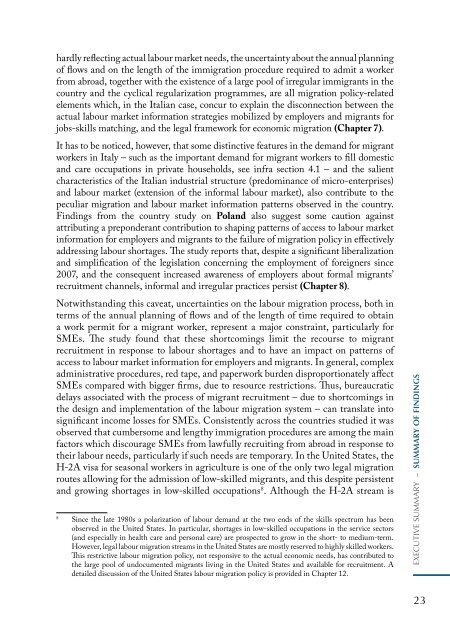International Organization for Migration (IOM)
International Organization for Migration (IOM)
International Organization for Migration (IOM)
You also want an ePaper? Increase the reach of your titles
YUMPU automatically turns print PDFs into web optimized ePapers that Google loves.
hardly reflecting actual labour market needs, the uncertainty about the annual planning<br />
of flows and on the length of the immigration procedure required to admit a worker<br />
from abroad, together with the existence of a large pool of irregular immigrants in the<br />
country and the cyclical regularization programmes, are all migration policy-related<br />
elements which, in the Italian case, concur to explain the disconnection between the<br />
actual labour market in<strong>for</strong>mation strategies mobilized by employers and migrants <strong>for</strong><br />
jobs-skills matching, and the legal framework <strong>for</strong> economic migration (Chapter 7).<br />
It has to be noticed, however, that some distinctive features in the demand <strong>for</strong> migrant<br />
workers in Italy – such as the important demand <strong>for</strong> migrant workers to fill domestic<br />
and care occupations in private households, see infra section 4.1 – and the salient<br />
characteristics of the Italian industrial structure (predominance of micro-enterprises)<br />
and labour market (extension of the in<strong>for</strong>mal labour market), also contribute to the<br />
peculiar migration and labour market in<strong>for</strong>mation patterns observed in the country.<br />
Findings from the country study on Poland also suggest some caution against<br />
attributing a preponderant contribution to shaping patterns of access to labour market<br />
in<strong>for</strong>mation <strong>for</strong> employers and migrants to the failure of migration policy in effectively<br />
addressing labour shortages. The study reports that, despite a significant liberalization<br />
and simplification of the legislation concerning the employment of <strong>for</strong>eigners since<br />
2007, and the consequent increased awareness of employers about <strong>for</strong>mal migrants’<br />
recruitment channels, in<strong>for</strong>mal and irregular practices persist (Chapter 8).<br />
Notwithstanding this caveat, uncertainties on the labour migration process, both in<br />
terms of the annual planning of flows and of the length of time required to obtain<br />
a work permit <strong>for</strong> a migrant worker, represent a major constraint, particularly <strong>for</strong><br />
SMEs. The study found that these shortcomings limit the recourse to migrant<br />
recruitment in response to labour shortages and to have an impact on patterns of<br />
access to labour market in<strong>for</strong>mation <strong>for</strong> employers and migrants. In general, complex<br />
administrative procedures, red tape, and paperwork burden disproportionately affect<br />
SMEs compared with bigger firms, due to resource restrictions. Thus, bureaucratic<br />
delays associated with the process of migrant recruitment – due to shortcomings in<br />
the design and implementation of the labour migration system – can translate into<br />
significant income losses <strong>for</strong> SMEs. Consistently across the countries studied it was<br />
observed that cumbersome and lengthy immigration procedures are among the main<br />
factors which discourage SMEs from lawfully recruiting from abroad in response to<br />
their labour needs, particularly if such needs are temporary. In the United States, the<br />
H-2A visa <strong>for</strong> seasonal workers in agriculture is one of the only two legal migration<br />
routes allowing <strong>for</strong> the admission of low-skilled migrants, and this despite persistent<br />
and growing shortages in low-skilled occupations 8 . Although the H-2A stream is<br />
8 Since the late 1980s a polarization of labour demand at the two ends of the skills spectrum has been<br />
observed in the United States. In particular, shortages in low-skilled occupations in the service sectors<br />
(and especially in health care and personal care) are prospected to grow in the short- to medium-term.<br />
However, legal labour migration streams in the United States are mostly reserved to highly skilled workers.<br />
This restrictive labour migration policy, not responsive to the actual economic needs, has contributed to<br />
the large pool of undocumented migrants living in the United States and available <strong>for</strong> recruitment. A<br />
detailed discussion of the United States labour migration policy is provided in Chapter 12.<br />
eXecutIve summAry – SUMMARY OF FINDINGS<br />
23


